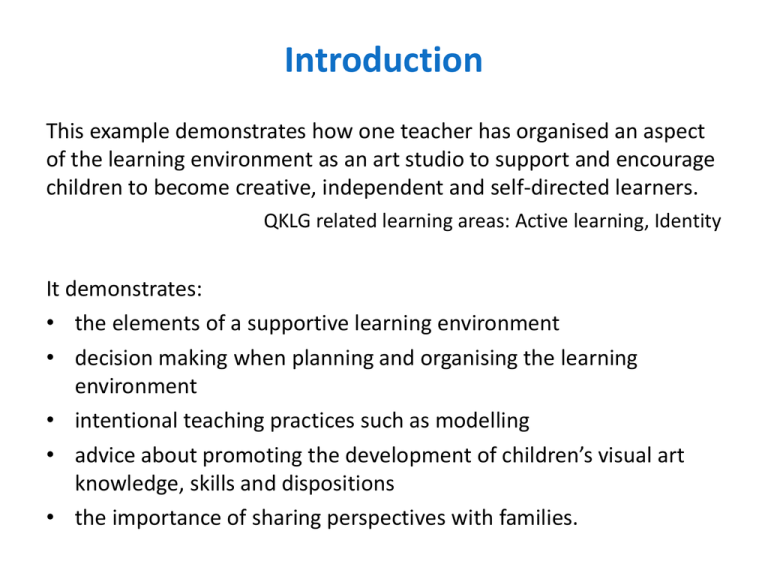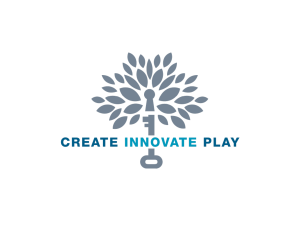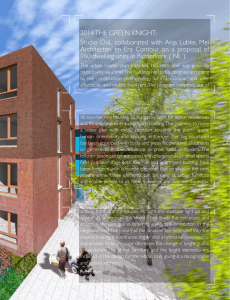The Art studio (PPT, 738 kB )
advertisement

Introduction This example demonstrates how one teacher has organised an aspect of the learning environment as an art studio to support and encourage children to become creative, independent and self-directed learners. QKLG related learning areas: Active learning, Identity It demonstrates: • the elements of a supportive learning environment • decision making when planning and organising the learning environment • intentional teaching practices such as modelling • advice about promoting the development of children’s visual art knowledge, skills and dispositions • the importance of sharing perspectives with families. The kindergarten art studio Chris-Anne Aroney, teacher trialling the Queensland kindergarten learning guideline A teacher’s perspective “Visual art and the concept of an art studio have always been a passion of mine because children are such eager explorers. Throughout their play, children are able to explore ideas, gain understandings and are free to make meaning of their world. One effective way of expressing these concepts is through drawing, painting and clay work.” Chris-Anne Aroney Designated space for an art studio Opportunities to use a wide variety of media and materials enable children to explore, experiment and play with colour, texture, shape and line. Presenting materials used in the art studio in a beautiful and aesthetically pleasing way invites children’s interest. A supportive learning environment The art studio demonstrates qualities of supportive learning spaces. Through the organisation of materials and furniture it combines the elements of: • practicality and ease of use • accessibility of materials • aesthetic appeal. A vehicle for intentional teaching The art studio also supports the development of children’s knowledge, skills and dispositions through intentional teaching practices. These practices promote: • independence • creativity • respect and appreciation for their own and other children’s work • engagement and excitement. QKLG related learning areas: Identity, Connectedness, Active learning Decision making: Organising the art studio Practicality, ease of use and accessibility of materials are priorities. In the art studio I have: • set a long table in the centre of the studio to allow children to work alongside or with each other • provided water and sponges that are readily accessible to encourage children to care for art materials • modelled care of equipment and encouraged children to clean their materials. Decision making: Getting started It takes time to intentionally demonstrate processes and support children’s attempts to clean and care for this space. Having an adult to provide prompts can be helpful. This may impact on when children can access the art studio at first. Decision making: Organising materials In the art studio, the selection and location of materials is important. It includes: • space that enables children to choose the items they wish to use • aesthetic presentation of materials that are changed regularly • access to clay, allowing children to sculpt and experiment with twoand three-dimensional forms • paint pumps to enable children to mix their own colours using a pallet. Other paints are also added over the year. • use of the store room to enable children to safely store materials needed for projects. Decision making: Selecting materials Promoting independence: • a variety of materials are presented in an organised manner for the children to select with ease • children spin a small table wheel to select various paints • art materials are located throughout the environment for ease of accessibility and to encourage independence. As the materials are always available, children may access them as: • an engaging experience in their own right or • to incorporate as part of a play scenario, such as adding a painting to the doctor’s surgery. Intentional teaching: Introducing knowledge, skills and dispositions I introduce materials: • initially, to the whole group of new children • during the year as new materials are added. Specific art techniques: • are introduced over the year • increase in complexity as the children become more confident and independent. Using real art terms and techniques allows the children to: • develop accurate vocabulary and understanding of art terms and techniques • build an appreciation of and respect for the visual arts. QKLG related learning areas: Active learning, Communicating Intentional teaching: Creating opportunities Children have many opportunities to use a wide variety of art materials allowing them to explore, experiment, play and represent ideas. This space invited children to look closely at themselves to create a self-portrait. Intentional teaching: Modelling use of materials Art techniques are taught through teacher modelling. When modelling the use of materials I explain ways to use them and demonstrate techniques for using the tools. Once children understand the techniques for using materials, the possibilities are amazing … For example, when we added water colours to the easels with various sized paint brushes I talked about the materials to the group. I then demonstrated the techniques, modelling the dip, wipe and paint method. Respecting the process, respecting the work Allowing children the necessary time to create their artworks demonstrates respect for the processes by which those pieces of art are made. Careful display of children’s artwork promotes a sense of respect, pride and appreciation in their work. Sharing perspectives and beliefs with parents to inspire involvement During a parent information evening, parents reflected on their image of the child. The staff also discussed their images of the child. We discovered some shared perspectives and beliefs about children. “ Children are eager to learn, and are capable, receptive, inquisitive individuals.” Parents were then invited to work collaboratively to represent their image of the child through the medium of paint, collage and pastels onto a large canvas. Accepting the challenge … The creative process began at the parent night. This canvas was also made available for the next two weeks for all parents to make their contributions. It now hangs in our art studio. Discoveries By physically engaging with the curriculum, the families agreed that their children were engaged in a living curriculum within an empowering learning environment – one that will truly equip them for a future of lifelong learning.








